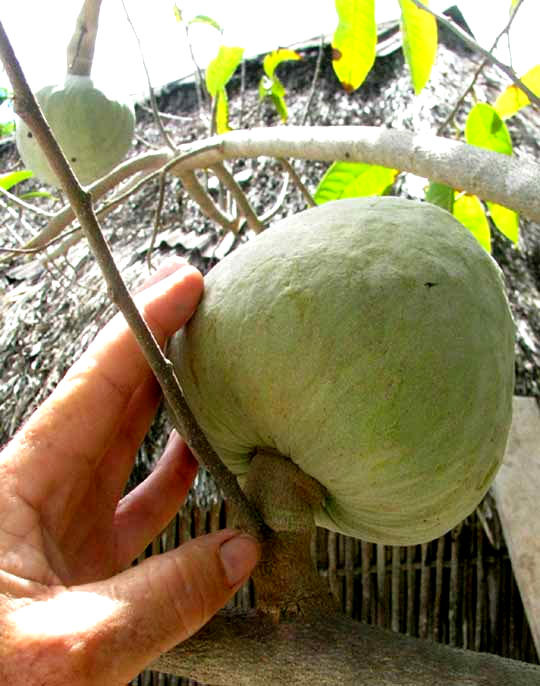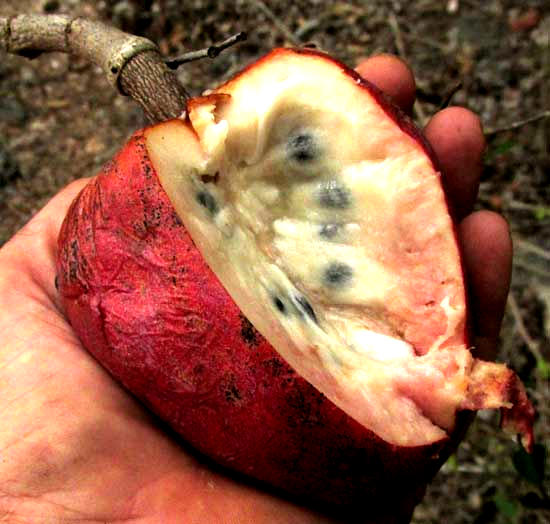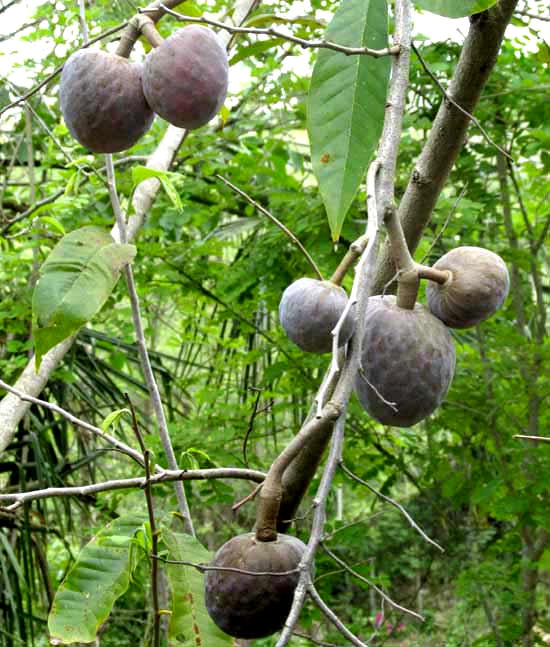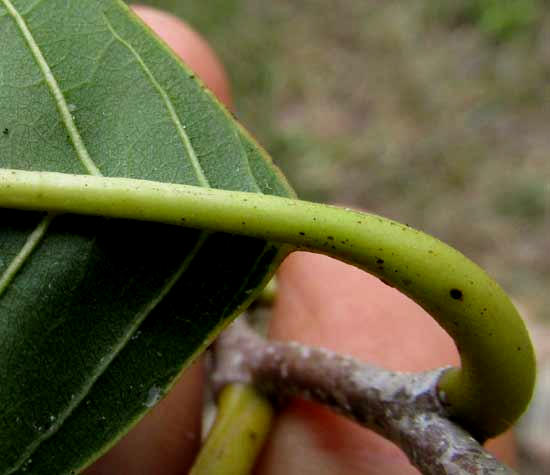Excerpts from Jim Conrad's
Naturalist Newsletter
from the March 25, 2012 Newsletter issued from Hacienda Chichen Resort beside Chichén Itzá Ruins; limestone bedrock; elevation ~39m (~128ft), N20.675°, W88.569°; central Yucatán state, MÉXICO
COMMON CUSTARD-APPLE
In Pisté nowadays a small tree is bearing the fruits shown below:

Folks here call it Anona, and books usually refer to it as the Common Custard-Apple, or Bullocks-Heart. It's ANNONA RETICULATA.
The Common Custard-Apple differs from other common Annona species by the fruit's smoother surface and spherical or heart-shaped form. It's so smooth that if you weren't looking for the more or less diamond-shaped bumps more obvious in the other species you might not notice them. Annona fruits are bumpy because they are "syncarp" fruits -- produced by flowers with more than one pistils, which merge together as the pistils mature. In Annona reticulata the pistils have merged so seamlessly that they're hardly recognizable in the mature fruit. The pattern on the fruit created by the merged pistils is referred to as "reticulation."
The Common Custard-Apple is thought to be native to most of tropical America, though now it's planted in the tropics worldwide, and in many countries its gone wild, or become "naturalized." Several cultivars are recognized, with fruit flesh varying from juicy and very aromatic to hard with a repulsive taste.
from the May 7, 2017 Newsletter issued from Rancho Regensis north of Valladolid, Yucatán, MÉXICO;
elevation ~40m (~130 ft), N~20.876°, W~88.170°
A CUSTARDY CUSTARD-APPLE
Late one afternoon this week my Maya friend Gener brought me the pretty fruit shown below:

The fruit had just been plucked from a planted tree not far from the hut. With its size, shape, and black seeds embedded in pasty pulp, it was obviously a member of the Custard-Apple/Pawpaw Family, the Annonaceae, genus Annona, and in fact Gener's Spanish name for it was anona. Members of the genus Annona are much planted throughout the world's tropics, and often are see around folks' houses here, but in all these years I've never managed to eat one like this at the peak of its ripeness. Normally wild animals or other humans get to them before I do, or else they fall to the ground and rot before I see them. Also I was glad to have this fruit because it's taken me awhile to get the Annona concept, and this would help me get a fix on them.
My moldy old Bailey's Manual of Cultivated Plants mentions four Annona species planted in the world's tropics because of their edible fruits. Recently we looked at the spiky-fruiting Guanábana, or Soursop, Annona muricata, at www.backyardnature.net/yucatan/soursop.htm
Other times we've encountered the Cherimoya, Annona cherimola, often displaying small "finger-print depressions" over the fruit's surface, as shown on our Cherimoya page at www.backyardnature.net/chiapas/anona.htm
Another Annona species we've seen, variously called Saramuyo, Sugar-Apple, Sweetsop, and Anona, is Annona squamosa, and is shown with its fruits looking a little like an artichoke with succulent segments, at www.backyardnature.net/yucatan/sweetsop.htm
And then there's the Custard-Apple or Bullocks-Heart, Annona reticulata, which we profile at www.backyardnature.net/yucatan/anona.htm
So, is Gener's red fruit any of these, or something else?
It's the last one, the Custard-Apple, just with a red fruit instead of the pale one shown on our page. Gener tells me that around here three kinds of "Annona" are found: A red one, a green one and a yellow one.
In fact, one reason it's been hard for me to get these species straight was Gener's "three kinds of Annona" and the fact that the similar Cherimoya produces many cultivars that range in shape from nearly spherical to conical. One important feature that helped me separate the various Custard-Apple cultivars from the various Cherimoya cultivars is that Cherimoya tree leaves are invested below with dense, short hairs -- they're "velvety-pubescent." That's not so with our Custard-Apple.
And, to confirm that Gener's anona was a Custard-Apple, after savoring the fruit I visited the tree the fruit had come from. Below, you can see several immature fruits still on the tree:

And below you can see a leaf's hairless underside and its hairless petiole:

Therefore: Gener's red anona was a Custard-Apple, Annona reticulata, a red-skinned cultivar. And I'm here to tell you that when the flesh is perfectly ripe it's soft and sweet exactly like a deliciously rich custard dessert, only beset with sizable hard, black seeds you're obliged to spit out.